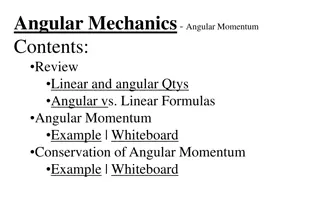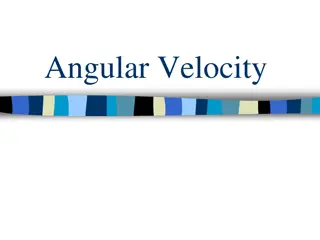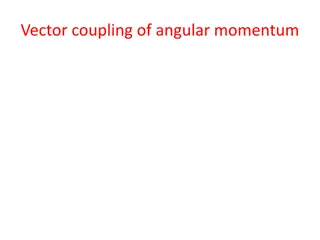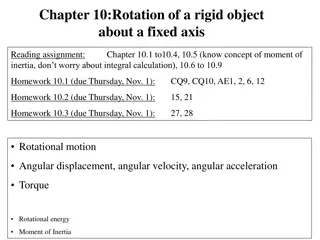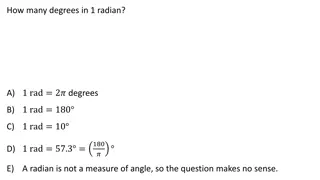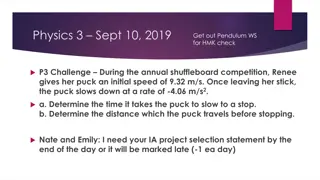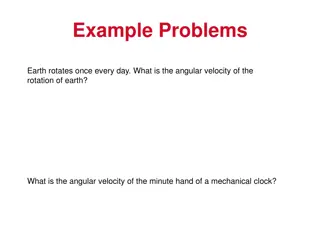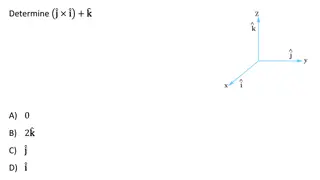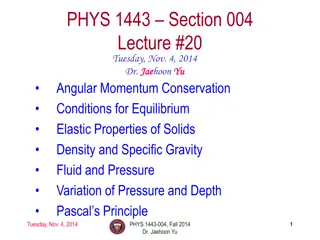Understanding Angular Overlap Method in Advanced Inorganic Chemistry
Exploring the Angular Overlap Method (AOM) in advanced inorganic chemistry provides a qualitative discussion on the physical rationale behind the theory of complexes. By considering the interaction of atomic orbitals and the degree of overlap, AOM offers insights into energy quantification in coordination compounds. This method, alongside Molecular Orbital Theory (MOT), helps illustrate the angular dependence of overlap integral, contributing to a comprehensive understanding of complex formation. Comparing AOM with Crystal Field Theory (CFT) reveals distinct approaches to analyzing the energies involved in coordination complexes.
- Inorganic chemistry
- Angular Overlap Method
- Coordination compounds
- Molecular Orbital Theory
- Energy quantification
Download Presentation

Please find below an Image/Link to download the presentation.
The content on the website is provided AS IS for your information and personal use only. It may not be sold, licensed, or shared on other websites without obtaining consent from the author. Download presentation by click this link. If you encounter any issues during the download, it is possible that the publisher has removed the file from their server.
E N D
Presentation Transcript
Advanced Advanced Inorganic Inorganic Chemistry By Dr. MAHMOUD NAJIM Chemistry Angular Angular Overlap Overlap Method Method
Molecular orbital diagram (Fig. 1)does not provide a complete understanding of the theory of complexes or a method to quantify the energies involved and one way to approach this problem is AOM which can illustrate a qualitative discussion of the physical rationale for the theory. Fig. 2 showed that the interaction of two atomic orbitals having symmetry appropriate for positive overlap to give a bonding and antibonding orbital with energy determined by the overlap and the energies of the originalorbitals. The degree of the overlap (SML) will depend upon the angle between the orbitals ( Fig. 3) which can be used as a basis of AOM to treat the coordination compoundsby MOT assumed to the following equation: SML= S cos . 1 The energy of interaction is takenas: = S2 ..2 ML Were is constant inversely proportional to the deference in energy between the original orbitals. Because it is constant for given metal ion and set of ligands, so only the angular dependence of the overlap integral need to be considered .
For the overlap of dz2 orbital with a ligand on the z axis( =0 ) and according to the functions for d orbitals given in Table we may rewrite the above equation as follows: 2 = S f( , ) 3 By using of the last equation and the Table considering the two eg orbitals of an octahedral set we can evaluate SML SML = .4 3/2 S ..4 Substitution of eq. 4 on eq. 2 we canhave = 3 S2 . 5 The same result should be determined for the second eg orbital Fig. 4 showed a comparison of the results from the AOM and CFT , these methods defined that 10Dq = 3 S 2
The source of the splitting energy of the t2g and eg(eg*) for AOM and CFT was referred to different causes. For CFT is the barycentre of the unpaired d orbitals while it is the barycentre for the unpaired d orbitals and the ligand donor orbitals for AOM, so it becomes 12 S 2 of MOSE immediately afterfour ligand electrons occupying the eg level for the metal ( 3 S 2 for eache) without regard to d electrons. Changing from d1- d3cause no change in the MOSE because t2g level strictly non bonding with -only system, although high spin d4will be less stabilized(12- 3) S2similar to weak field case(Table). For various geometry it is easy to determine SMLaccording to the Table and by repeating the previouscalculation we can obtain: 2 EZ2 = (1/4+ + +1/4 ) S 6 2 2 =( + 3/4 +3/4+3/4) S2 ..7 Ex - y For square planar the destabilizations of S 2 for occupation of the *Z2 antibonding orbital and of 3 S 2 for the occupation of * 2 y2 orbital x
For the occupation of *x2 y2 orbital t2 and e levels in tetrahedral symmetry Exz = Exy = Eyz = 4/3 S2 .8 Ex2 y2 =Ez2= 0 ..9 This last equation is of considerable interest which can show that Dq(tet)=4/9Dq(oct) as below 2 2 4/3 S ( tetr.) / 3 S ( oct.) = 4/9 . 10 As a comparison between VBT, CFT and MOT we can refer to the following: 1 Both CFT and MOT described coordination complexes by the existence of two sets of orbitals separated by an energy gaps, 10Dq = 3 S ,if the energy to pair the electrons is greater than this , high spin complexes will form otherwise low spin will formed. 2Both CFT and MOT showed that the visible spectra of the to electronic transitions such as t2g eg* , but the fundamental assumptions were different. 3Both CFT and MOT describe complexes in terms of interactions metal orbitals and the ligands and with the greater the interactions the greater of the amount of 10Dq, and then the greater metal- ligand bond not from the amounts of the electrostaticeffects. 4VBT concentrate only on the formation of d2sp3 hybridization which agree with the MOT description ( a1g, t1u and eg molecular orbitals). 2 complexes are attributed
- Bonding in metal complexes - Bonding is very useful in explaining the stability of many complexes , in addition to -bonding formed betweenM-L Some ligands can formed - Bonds when it consists appropriate orbitals for - Bonding with a metal d-orbitals (t2g) Three types of ligands can do that: 1 Ligands with p-orbitals perpindicular to the -bond 2 Ligands with a d-orbital lying in a plane that include the metal atom. 3 Ligands with a * orbital lying in a plane that include the metal atom ( Fig. 6a,b and c respectively) The effect of the bonding on the value of o depends on whether the ligand orbitals act as electron donors or acceptors There are two principles to be described , the first when atomic orbitals overlap strongly , they mix strongly , and the resulting bonding molecular orbitals are significantly lower in energy and the antibonding molecular orbitals are significantly higher in energy than the atomic orbitals. Second when the two atomic orbitals have similar energies they interact strongly , but with large different energies they mix only slightly even if there overlap islarge.
(Fig. 6) Bonding between metal d-orbital & Ligand a) Lp Md , b) Ld Md , c) L * -Md
1 The ligand with filled orbitals has no low energy vacant orbitals and they lie lower in energy than the partially filled d orbitals of the metals. They form a molecular orbitals, bonding lower than the ligand orbitals and antibonding lie above the energy of the d orbitals of the free metal ion.(Fig. 7). As a result a strong - donor ligand interaction decrease o . 2 A ligands that can accept electrons into their orbitals , we will see that such ligand lie higher in spectrachemical series and give rise to a large ligand field splitting parameter. These ligands has filled orbitals at lower energies than metal t2g orbitals and low energy empty orbitals that are available for occupation. The -acceptor orbitals are vacant antibonding orbitals on the ligand, as in CO and N2, and these orbitals lie above the metal d orbital in energy. When these vacant * ligand orbitals are close in energy to the metal t2 g orbitals andthe metal-ligand overlap is strong, a little e density will be delocalized from the metal to the ligand . As example the * orbital of CO has its larger amplititude on the C atom, while the full bonding orbitals of CO is low in energy and is largely localized on the O atom( as O is more electronegative than C), and will make CO behave as a net acceptor. Most ligands with acceptor orbitals are higher in energy than the metal d orbitals, they form molecular orbitals with the metal in which d orbitals character are lowered in energy, and the net result is that o is increased by the -acceptor interaction ( like Cl-, H2O),
(Fig. 7) The effect of the bonding on the ligand field spliting parameter a) acceptor b) donor
The important rule on bonding is clear on the order of the ligands in the spectrochemical series which can be divided asbelow: -donor < weak -donor < no effects< acceptor I- < Br- < Cl- < F- < H2O < NH2 < PR3 < CO Tetrahedral species can be divided roughly into two broad clases: 1 Oxo species in which the metal ion is high in oxidation state ( > or =6)and be very extensive bonding(MnO4-,CrO4-) 2 Complexes with lower oxidation state ( +2,+3) and the ligands are halide ions, amine or RO-



